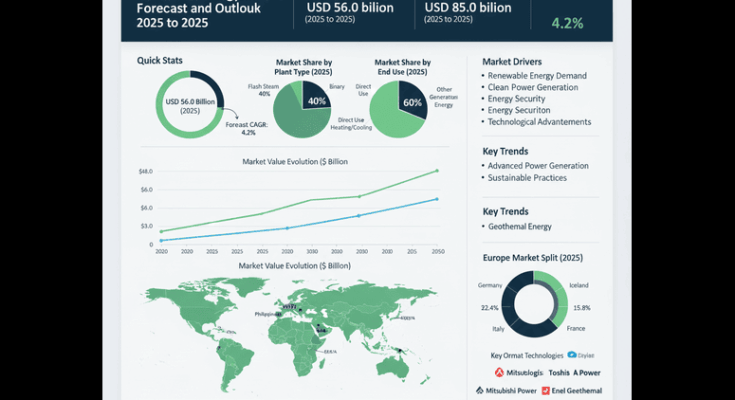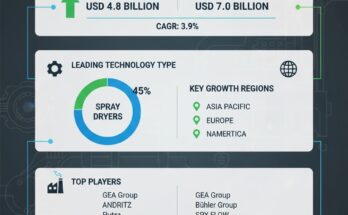The global geothermal energy market is entering a decade of transformation, with its total value forecast to rise from USD 56.0 billion in 2025 to USD 85.0 billion by 2035, representing an absolute increase of USD 29.0 billion and an impressive CAGR of 4.2%. This steady and sustained expansion underscores the sector’s growing role as a cornerstone of the global clean energy transition, providing reliable, low-emission power solutions for both industrial and grid-scale applications.
According to the latest Fact.MR industry outlook report, the geothermal market’s 51.8% growth trajectory reflects increasing investments in renewable infrastructure, accelerating demand for energy security, and widespread adoption of advanced geothermal systems in power generation, industrial heating, and HVAC applications.
A Market on the Rise
The geothermal energy market is expected to expand by nearly 1.5X between 2025 and 2035, with flash steam systems maintaining dominance as the leading plant type, representing approximately 40% of global installations. These systems deliver an optimal balance between cost efficiency and performance, positioning them as the preferred choice for industrial-scale power generation.
Between 2025 and 2030 alone, the market is expected to grow by USD 13.5 billion, capturing nearly 47% of the total forecasted decade-long increase. This initial growth phase will be fueled by a combination of factors — from evolving clean energy policies and heightened environmental compliance requirements to technological innovation in power generation infrastructure. Geothermal technology is no longer niche — it’s becoming foundational,” said a senior research analyst at Fact.MR. “As energy systems shift toward net-zero pathways, geothermal stands out as one of the most reliable and sustainable baseload power sources available globally.”
Key Growth Drivers
-
Renewable Energy Integration: As global economies intensify their net-zero commitments, geothermal energy provides continuous, carbon-free power — a distinct advantage over intermittent renewables like solar or wind.
-
Industrial Heating & Cooling Demand: The HVAC and industrial process heating segments are expanding rapidly, with ground-source heat pumps accounting for 15–18% of total geothermal applications, offering significant energy savings and carbon reduction benefits.
-
Government Policy & Energy Security: From Indonesia to Iceland, national energy strategies are increasingly recognizing geothermal’s potential to stabilize local grids, reduce import dependency, and stimulate industrial innovation.
-
Technological Evolution: Enhanced Geothermal Systems (EGS), binary cycle innovations, and smart grid integration are improving output efficiency while reducing operational costs — creating new investment opportunities for manufacturers and technology providers.
Regional Hotspots & High-Growth Markets
The Asia-Pacific region is forecast to be the fastest-growing geothermal market, led by Indonesia (5.5% CAGR) and the Philippines (4.8% CAGR) through 2035. These nations are investing heavily in geothermal infrastructure to support industrialization and meet surging domestic power demand. Together, they represent a potential USD 25 billion in incremental revenue opportunity by 2035.
-
Indonesia is spearheading Southeast Asia’s geothermal expansion, leveraging abundant natural resources and favorable government policy frameworks to modernize its power sector.
-
The Philippines continues to solidify its position as a global geothermal leader through policy incentives and infrastructure upgrades aimed at expanding baseload renewable capacity.
-
The United States retains technology leadership with a 3.8% CAGR, driven by innovation in geothermal integration with grid and smart energy systems.
-
Kenya and Turkey are emerging as regional powerhouses, showcasing strong project pipelines supported by public-private partnerships and advanced exploration initiatives.
-
Europe, led by Germany, Iceland, and Italy, will grow from USD 19.6 billion in 2025 to nearly USD 30 billion by 2035, emphasizing energy innovation and carbon neutrality goals.
Technology Pathways and Market Segments
The geothermal industry is evolving along seven key opportunity pathways:
-
Flash Steam Dominance (40% share): Commanding the largest market share, with revenues projected between USD 22–34 billion, flash steam systems remain the backbone of geothermal electricity production.
-
Power Generation Leadership (60% share): Representing the primary demand driver, this segment alone is valued between USD 33–51 billion through 2035.
-
Binary Cycle Premium Segment: Targeting specialized industrial applications with high-temperature and performance-sensitive processes; projected at USD 17–25 billion.
-
Asian Market Acceleration: Emerging markets in Southeast Asia represent USD 10–25 billion in expansion potential through localized manufacturing and partnerships.
-
Advanced Technology Systems: Enhanced geothermal and automation systems add USD 5–12 billion in technology premiums.
-
Supply Chain Optimization: Efficient equipment management and localized service networks could contribute USD 4–10 billion in added market value.
-
Emerging Applications: Direct heating, cooling, and district energy networks could generate USD 3–8 billion in incremental demand.
Competitive Landscape: Innovation at the Core
The market is defined by a mix of global powerhouses and specialized energy innovators. Ormat Technologies, Mitsubishi Power, Toshiba Energy, Enel Green Power, Chevron Geothermal, Reykjavik Energy, and Fuji Electric lead the competitive landscape, focusing on technology advancement, system reliability, and clean energy performance.
These companies are actively investing in:
-
Performance optimization and automated control systems
-
Integrated supply chain management to ensure reliability
-
Digital monitoring solutions for predictive maintenance
-
Collaborative R&D partnerships to improve plant efficiency and cost-effectiveness
Emerging players such as Pertamina Geothermal, Sumitomo Corporation, and Energy Development Corporation (EDC) are strengthening their regional presence through vertical integration and domestic project expansion.
Strategic Outlook for Manufacturers & Investors
For industrial manufacturers and technology suppliers, the geothermal energy market represents an expanding frontier where engineering precision meets sustainability demand. Opportunities exist across power equipment manufacturing, thermal systems, digital control infrastructure, and supply chain optimization. As advanced materials and smart technologies enable higher efficiency, geothermal systems are increasingly being integrated into hybrid renewable energy frameworks.
Browse Full Report : https://www.factmr.com/report/geothermal-energy-market
About Fact.MR
Fact.MR is a global market research and consulting firm offering actionable insights across more than 6,000 industries. Our geothermal energy market report (Report ID: FACT8815MR, Oct 2025) provides a comprehensive 170-page analysis with 24 data tables and 69 figures, covering quantitative forecasts, regional trends, and competitive benchmarking.



